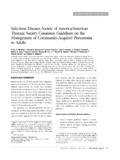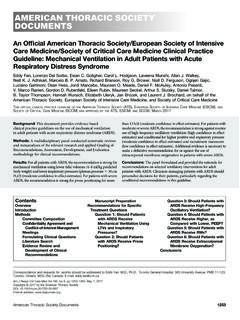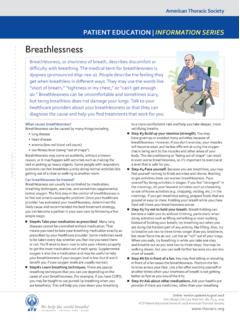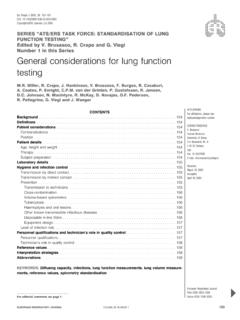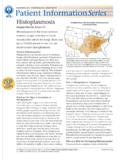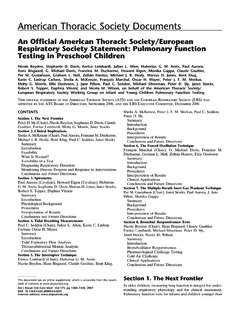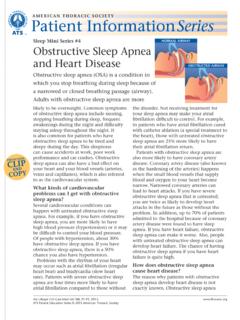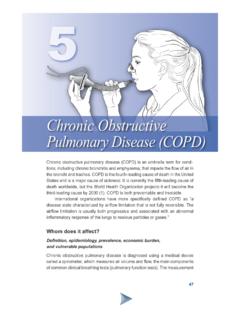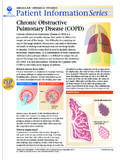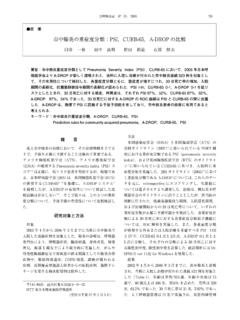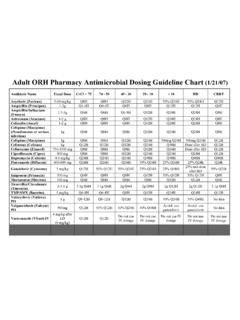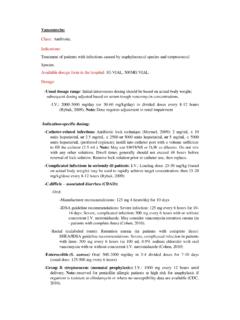Transcription of American Thoracic Society Documents
1 American Thoracic Society DocumentsGuidelines for the Management of Adults withHospital- acquired , Ventilator-associated, andHealthcare-associated PneumoniaThis official statement of the American Thoracic Society and the Infectious Diseases Society of America was approvedby the ATS Board of Directors, December2004and the IDSA Guideline Committee, October2004 CONTENTSE xecutive SummaryIntroductionMethodology Used to Prepare the GuidelineEpidemiologyIncidenceEtiologyMa jor Epidemiologic PointsPathogenesisMajor Points for PathogenesisModifiable Risk FactorsIntubation and Mechanical VentilationAspiration, Body Position, and Enteral FeedingModulation of Colonization.
2 Oral Antiseptics and AntibioticsStress Bleeding Prophylaxis, Transfusion, and Glucose ControlMajor Points and Recommendations for ModifiableRisk FactorsDiagnostic TestingMajor Points and Recommendations for DiagnosisDiagnostic Strategies and ApproachesClinical StrategyBacteriologic StrategyRecommended Diagnostic StrategyMajor Points and Recommendations for ComparingDiagnostic StrategiesAntibiotic Treatment of hospital - acquired PneumoniaGeneral ApproachInitial Empiric Antibiotic TherapyAppropriate Antibiotic Selection and Adequate DosingLocal Instillation and Aerosolized
3 AntibioticsCombination versus MonotherapyDuration of TherapyMajor Points and Recommendations for OptimalAntibiotic TherapySpecific Antibiotic RegimensAntibiotic Heterogeneity and Antibiotic CyclingResponse to TherapyModification of Empiric Antibiotic RegimensDefining the Normal Pattern of ResolutionReasons for Deterioration or NonresolutionEvaluation of the Nonresponding PatientMajor Points and Recommendations for AssessingResponse to TherapySuggested Performance IndicatorsEXECUTIVE SUMMARYS ince the initial 1996 American Thoracic Society (ATS) guide-line on nosocomial pneumonia, a number of new developmentsAm J Respir Crit Care Med Vol 171.
4 Pp 388 416, 2005 DOI: address: appeared, mandating a new evidence-based guideline forhospital- acquired pneumonia (HAP), including healthcare-asso-ciated pneumonia (HCAP) and ventilator-associated pneumonia(VAP). This document, prepared by a joint committee of theATS and Infectious Diseases Society of America (IDSA), fo-cuses on the epidemiology and pathogenesis of bacterial pneu-monia in adults, and emphasizes modifiable risk factors for infec-tion. In addition, the microbiology of HAP is reviewed, with anemphasis on multidrug-resistant (MDR) bacterial pathogens,such asPseudomonas aeruginosa,Acinetobacterspecies, andmethicillin-resistantStaphylococcus aureus.
5 Controversies aboutdiagnosis are discussed, emphasizing initial examination of lowerrespiratory tract samples for bacteria, and the rationale for bothclinical and bacteriologic approaches, using either semiquanti-tative or quantitative microbiologic methods that help directselection of appropriate antibiotic therapy. We also provide rec-ommendations for additional diagnostic and therapeutic evalua-tions in patients with nonresolving pneumonia. This is an evi-dence-based document that emphasizes the issues of VAP,because there are far fewer data available about HAP in nonintu-bated patients and about HCAP.
6 By extrapolation, patients whoare not intubated and mechanically ventilated should be man-aged like patients with VAP, using the same approach to identifyrisk factors for infection with specific major goals of this evidence-based guideline for the man-agement of HAP, VAP, and HCAP emphasize early, appropriateantibiotics in adequate doses, while avoiding excessive antibiot-ics by de-escalation of initial antibiotic therapy, based on micro-biologic cultures and the clinical response of the patient, andshortening the duration of therapy to the minimum effectiveperiod.
7 The guideline recognizes the variability of bacteriologyfrom one hospital to another and from one time period to an-other and recommends taking local microbiologic data into ac-count when adapting treatment recommendations to any specificclinical setting. The initial, empiric antibiotic therapy algorithmincludes two groups of patients: one with no need for broad-spectrum therapy, because these patients have early-onset HAP,VAP, or HCAP and no risk factors for MDR pathogens, and asecond group that requires broad-spectrum therapy, because oflate-onset pneumonia or other risk factors for infection withMDR of the key recommendations and principles in this new,evidence-based guideline are as follows.
8 HCAP is included in the spectrum of HAP and VAP, andpatients with HCAP need therapy for MDR pathogens. A lower respiratory tract culture needs to be collectedfrom all patients before antibiotic therapy, but collectionof cultures should not delay the initiation of therapy incritically ill patients. Either semiquantitative or quantitative culture datacan be used for the management of patients with HAP. Lower respiratory tract cultures can be obtained broncho- American Thoracic Society Documents389scopically or nonbronchoscopically, and can be culturedquantitatively or semiquantitatively.
9 Quantitative cultures increase specificity of the diagnosisof HAP without deleterious consequences, and the specificquantitative technique should be chosen on the basis oflocal expertise and experience. Negative lower respiratory tract cultures can be used tostop antibiotic therapy in a patient who has had culturesobtained in the absence of an antibiotic change in the past72 hours. Early, appropriate, broad-spectrum, antibiotic therapyshould be prescribed with adequate doses to optimize anti-microbial efficacy.
10 An empiric therapy regimen should include agents that arefrom a different antibiotic class than the patient has re-cently received. Combination therapy for a specific pathogen should beused judiciously in the therapy of HAP, and considerationshould be given to short-duration (5 days) aminoglycosidetherapy, when used in combination with a -lactam to treatP. aeruginosapneumonia. Linezolid is an alternative to vancomycin, and uncon-firmed, preliminary data suggest it may have an advantagefor proven VAP due to methicillin-resistantS.
